HI6027 Business and Corporate Law Case Study: Analysis and Application
VerifiedAdded on 2022/10/17
|6
|1128
|12
Case Study
AI Summary
This case study analyzes a scenario involving a company, its managing director, and a bank, focusing on the application of the Turquand Rule (Doctrine of Indoor Management) and relevant sections of the Corporation Act 2001. The issue revolves around whether the bank is entitled to a remedy for a loan provided to the company, despite potential internal irregularities. The solution applies the Turquand Rule, emphasizing that the bank is not responsible for the company's internal affairs, and therefore, is entitled to recover the loan. The analysis also considers the objectives of the company and the director's authority under the Act. The conclusion reinforces the bank's entitlement to the loan recovery, irrespective of the loan's purpose or the bank's knowledge of internal conflicts. The case study provides a detailed explanation of the legal principles, including references to relevant cases and sections of the Corporation Act 2001, such as section 125 and 126, to support the arguments and conclusions.
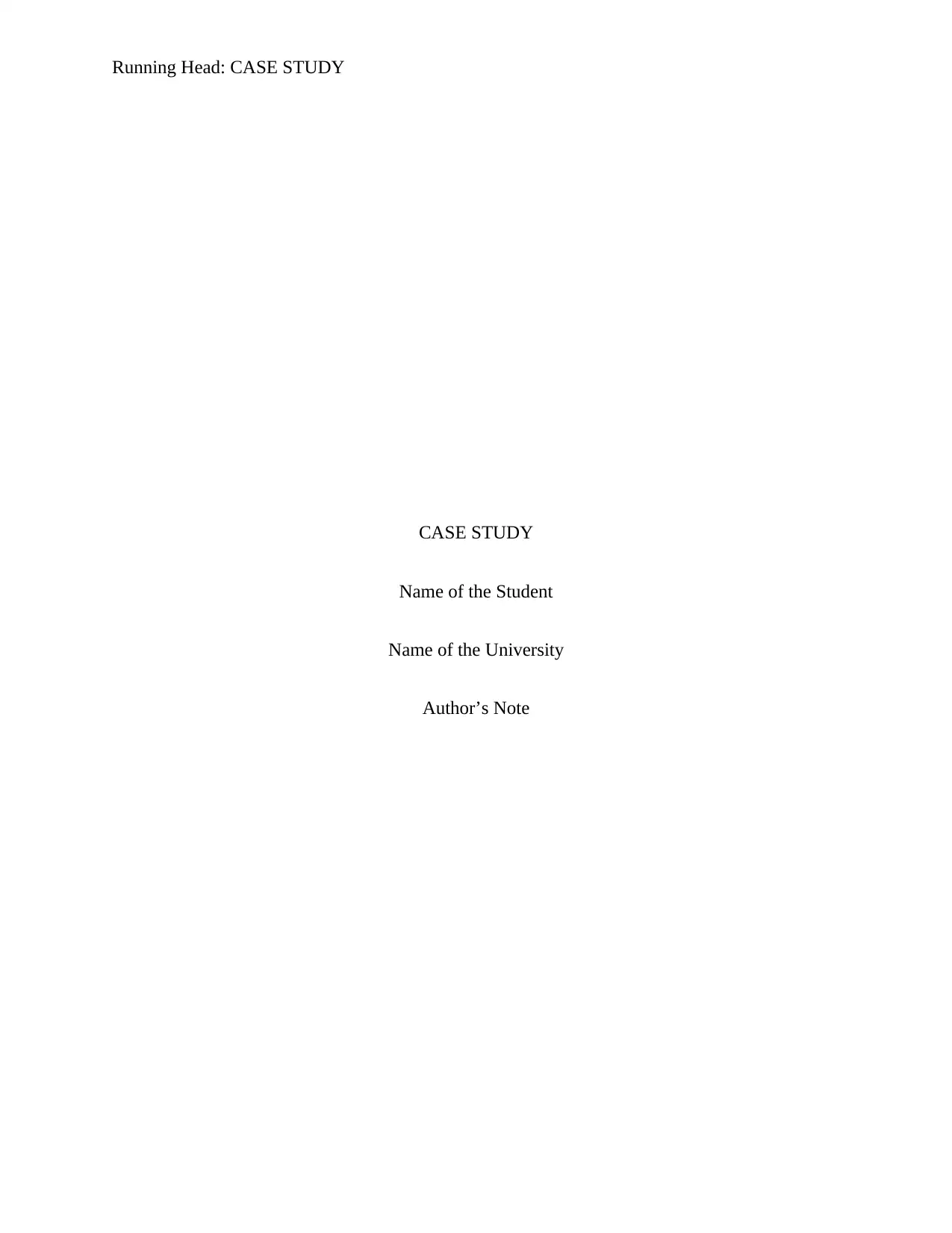
Running Head: CASE STUDY
CASE STUDY
Name of the Student
Name of the University
Author’s Note
CASE STUDY
Name of the Student
Name of the University
Author’s Note
Paraphrase This Document
Need a fresh take? Get an instant paraphrase of this document with our AI Paraphraser
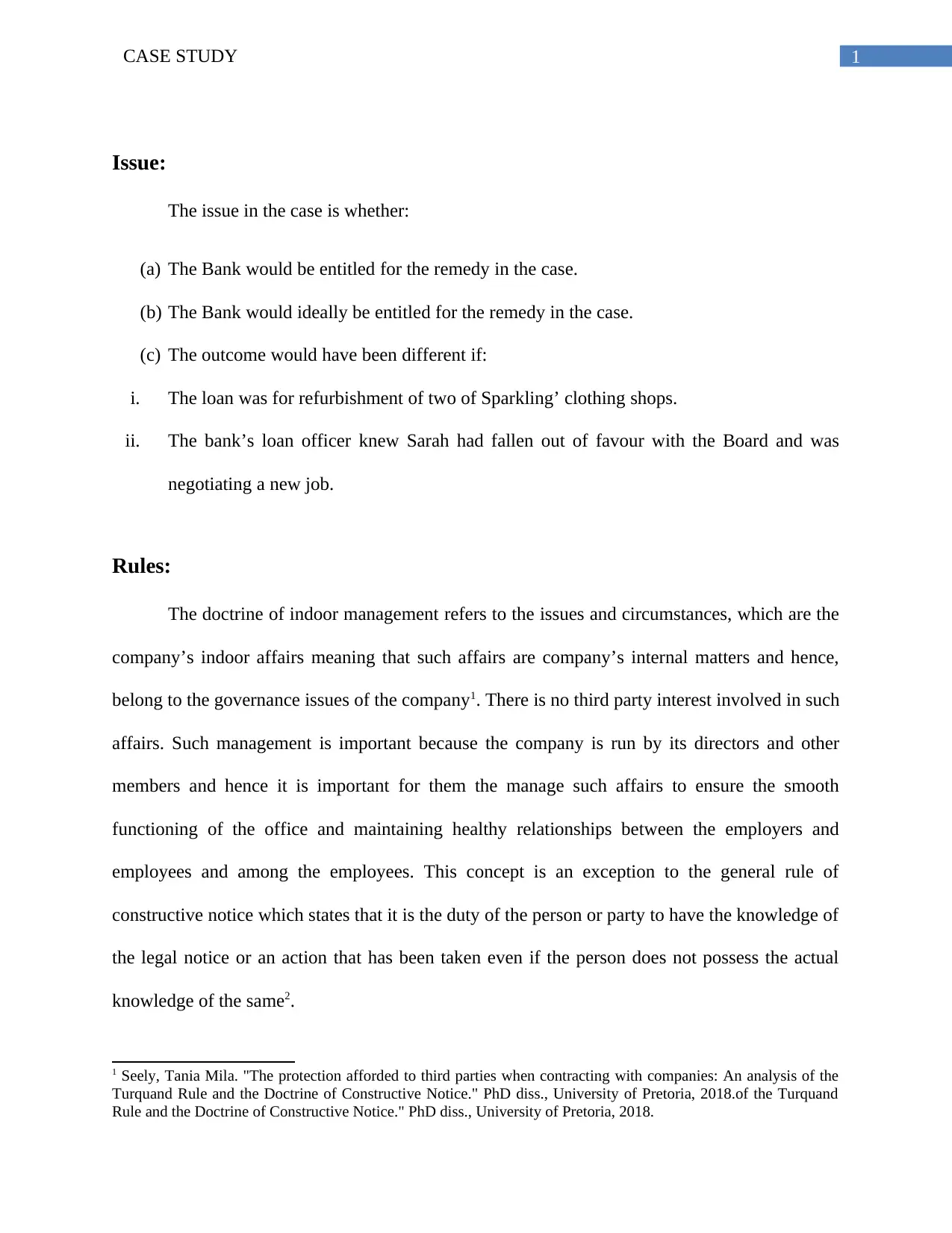
1CASE STUDY
Issue:
The issue in the case is whether:
(a) The Bank would be entitled for the remedy in the case.
(b) The Bank would ideally be entitled for the remedy in the case.
(c) The outcome would have been different if:
i. The loan was for refurbishment of two of Sparkling’ clothing shops.
ii. The bank’s loan officer knew Sarah had fallen out of favour with the Board and was
negotiating a new job.
Rules:
The doctrine of indoor management refers to the issues and circumstances, which are the
company’s indoor affairs meaning that such affairs are company’s internal matters and hence,
belong to the governance issues of the company1. There is no third party interest involved in such
affairs. Such management is important because the company is run by its directors and other
members and hence it is important for them the manage such affairs to ensure the smooth
functioning of the office and maintaining healthy relationships between the employers and
employees and among the employees. This concept is an exception to the general rule of
constructive notice which states that it is the duty of the person or party to have the knowledge of
the legal notice or an action that has been taken even if the person does not possess the actual
knowledge of the same2.
1 Seely, Tania Mila. "The protection afforded to third parties when contracting with companies: An analysis of the
Turquand Rule and the Doctrine of Constructive Notice." PhD diss., University of Pretoria, 2018.of the Turquand
Rule and the Doctrine of Constructive Notice." PhD diss., University of Pretoria, 2018.
Issue:
The issue in the case is whether:
(a) The Bank would be entitled for the remedy in the case.
(b) The Bank would ideally be entitled for the remedy in the case.
(c) The outcome would have been different if:
i. The loan was for refurbishment of two of Sparkling’ clothing shops.
ii. The bank’s loan officer knew Sarah had fallen out of favour with the Board and was
negotiating a new job.
Rules:
The doctrine of indoor management refers to the issues and circumstances, which are the
company’s indoor affairs meaning that such affairs are company’s internal matters and hence,
belong to the governance issues of the company1. There is no third party interest involved in such
affairs. Such management is important because the company is run by its directors and other
members and hence it is important for them the manage such affairs to ensure the smooth
functioning of the office and maintaining healthy relationships between the employers and
employees and among the employees. This concept is an exception to the general rule of
constructive notice which states that it is the duty of the person or party to have the knowledge of
the legal notice or an action that has been taken even if the person does not possess the actual
knowledge of the same2.
1 Seely, Tania Mila. "The protection afforded to third parties when contracting with companies: An analysis of the
Turquand Rule and the Doctrine of Constructive Notice." PhD diss., University of Pretoria, 2018.of the Turquand
Rule and the Doctrine of Constructive Notice." PhD diss., University of Pretoria, 2018.
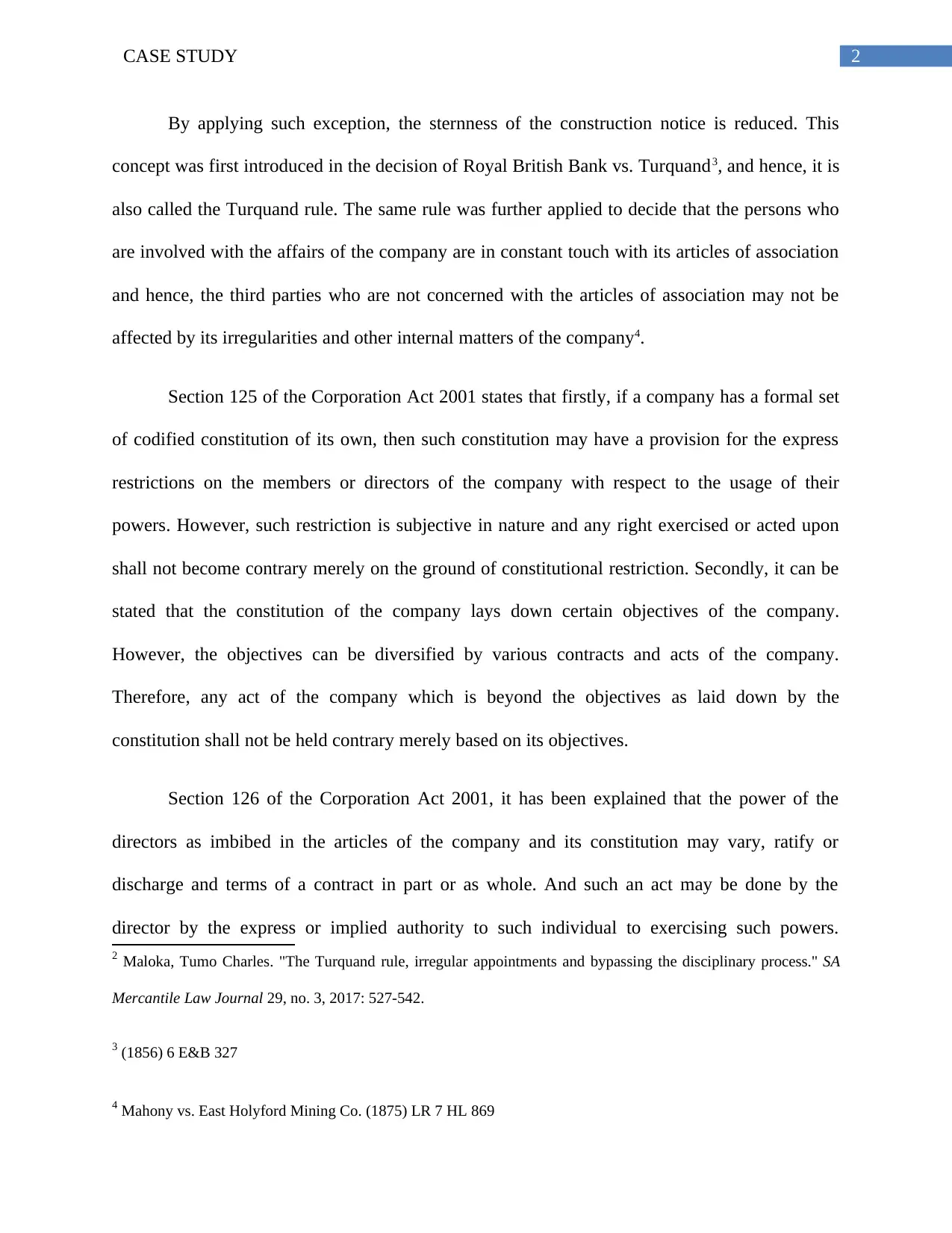
2CASE STUDY
By applying such exception, the sternness of the construction notice is reduced. This
concept was first introduced in the decision of Royal British Bank vs. Turquand3, and hence, it is
also called the Turquand rule. The same rule was further applied to decide that the persons who
are involved with the affairs of the company are in constant touch with its articles of association
and hence, the third parties who are not concerned with the articles of association may not be
affected by its irregularities and other internal matters of the company4.
Section 125 of the Corporation Act 2001 states that firstly, if a company has a formal set
of codified constitution of its own, then such constitution may have a provision for the express
restrictions on the members or directors of the company with respect to the usage of their
powers. However, such restriction is subjective in nature and any right exercised or acted upon
shall not become contrary merely on the ground of constitutional restriction. Secondly, it can be
stated that the constitution of the company lays down certain objectives of the company.
However, the objectives can be diversified by various contracts and acts of the company.
Therefore, any act of the company which is beyond the objectives as laid down by the
constitution shall not be held contrary merely based on its objectives.
Section 126 of the Corporation Act 2001, it has been explained that the power of the
directors as imbibed in the articles of the company and its constitution may vary, ratify or
discharge and terms of a contract in part or as whole. And such an act may be done by the
director by the express or implied authority to such individual to exercising such powers.
2 Maloka, Tumo Charles. "The Turquand rule, irregular appointments and bypassing the disciplinary process." SA
Mercantile Law Journal 29, no. 3, 2017: 527-542.
3 (1856) 6 E&B 327
4 Mahony vs. East Holyford Mining Co. (1875) LR 7 HL 869
By applying such exception, the sternness of the construction notice is reduced. This
concept was first introduced in the decision of Royal British Bank vs. Turquand3, and hence, it is
also called the Turquand rule. The same rule was further applied to decide that the persons who
are involved with the affairs of the company are in constant touch with its articles of association
and hence, the third parties who are not concerned with the articles of association may not be
affected by its irregularities and other internal matters of the company4.
Section 125 of the Corporation Act 2001 states that firstly, if a company has a formal set
of codified constitution of its own, then such constitution may have a provision for the express
restrictions on the members or directors of the company with respect to the usage of their
powers. However, such restriction is subjective in nature and any right exercised or acted upon
shall not become contrary merely on the ground of constitutional restriction. Secondly, it can be
stated that the constitution of the company lays down certain objectives of the company.
However, the objectives can be diversified by various contracts and acts of the company.
Therefore, any act of the company which is beyond the objectives as laid down by the
constitution shall not be held contrary merely based on its objectives.
Section 126 of the Corporation Act 2001, it has been explained that the power of the
directors as imbibed in the articles of the company and its constitution may vary, ratify or
discharge and terms of a contract in part or as whole. And such an act may be done by the
director by the express or implied authority to such individual to exercising such powers.
2 Maloka, Tumo Charles. "The Turquand rule, irregular appointments and bypassing the disciplinary process." SA
Mercantile Law Journal 29, no. 3, 2017: 527-542.
3 (1856) 6 E&B 327
4 Mahony vs. East Holyford Mining Co. (1875) LR 7 HL 869
⊘ This is a preview!⊘
Do you want full access?
Subscribe today to unlock all pages.

Trusted by 1+ million students worldwide
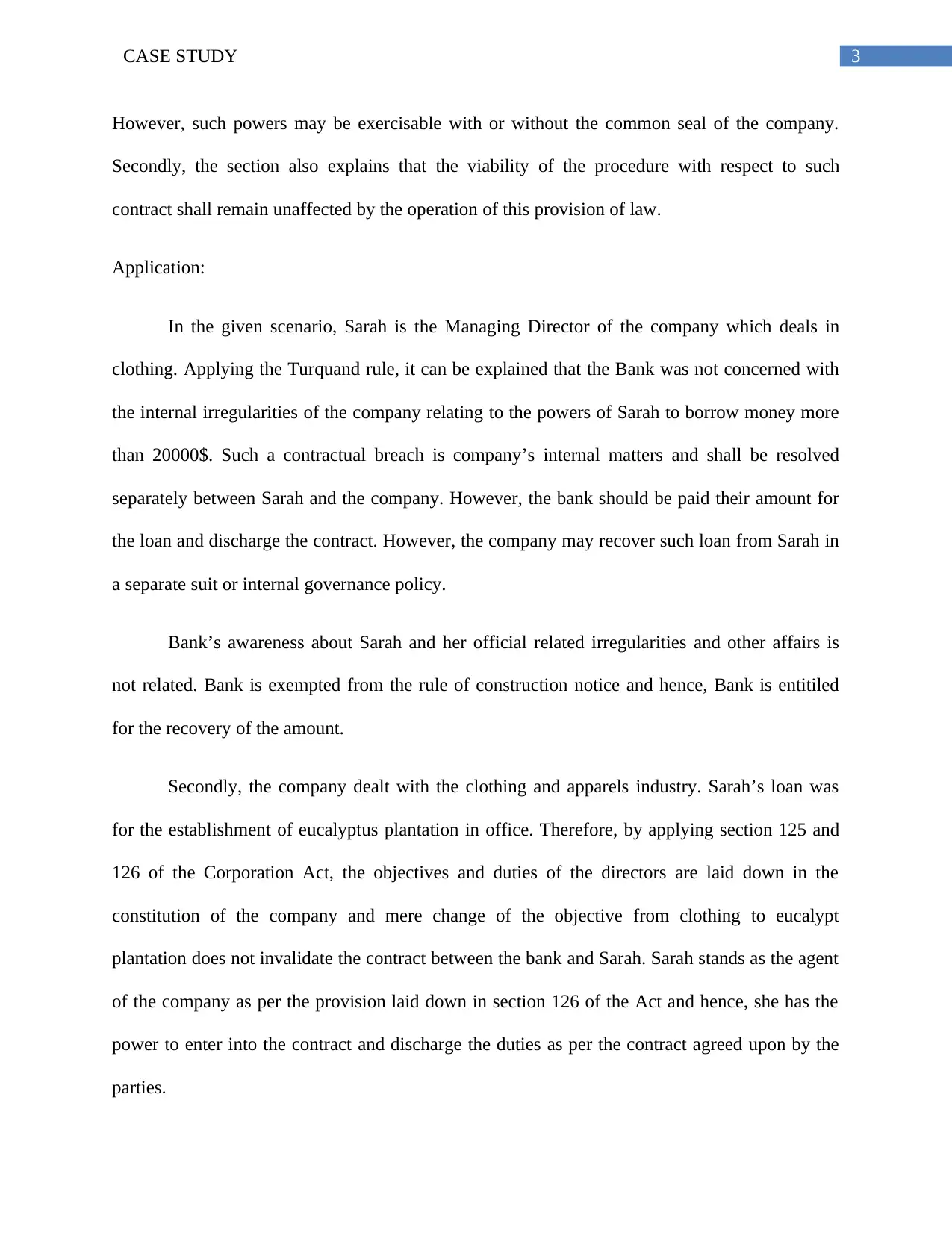
3CASE STUDY
However, such powers may be exercisable with or without the common seal of the company.
Secondly, the section also explains that the viability of the procedure with respect to such
contract shall remain unaffected by the operation of this provision of law.
Application:
In the given scenario, Sarah is the Managing Director of the company which deals in
clothing. Applying the Turquand rule, it can be explained that the Bank was not concerned with
the internal irregularities of the company relating to the powers of Sarah to borrow money more
than 20000$. Such a contractual breach is company’s internal matters and shall be resolved
separately between Sarah and the company. However, the bank should be paid their amount for
the loan and discharge the contract. However, the company may recover such loan from Sarah in
a separate suit or internal governance policy.
Bank’s awareness about Sarah and her official related irregularities and other affairs is
not related. Bank is exempted from the rule of construction notice and hence, Bank is entitiled
for the recovery of the amount.
Secondly, the company dealt with the clothing and apparels industry. Sarah’s loan was
for the establishment of eucalyptus plantation in office. Therefore, by applying section 125 and
126 of the Corporation Act, the objectives and duties of the directors are laid down in the
constitution of the company and mere change of the objective from clothing to eucalypt
plantation does not invalidate the contract between the bank and Sarah. Sarah stands as the agent
of the company as per the provision laid down in section 126 of the Act and hence, she has the
power to enter into the contract and discharge the duties as per the contract agreed upon by the
parties.
However, such powers may be exercisable with or without the common seal of the company.
Secondly, the section also explains that the viability of the procedure with respect to such
contract shall remain unaffected by the operation of this provision of law.
Application:
In the given scenario, Sarah is the Managing Director of the company which deals in
clothing. Applying the Turquand rule, it can be explained that the Bank was not concerned with
the internal irregularities of the company relating to the powers of Sarah to borrow money more
than 20000$. Such a contractual breach is company’s internal matters and shall be resolved
separately between Sarah and the company. However, the bank should be paid their amount for
the loan and discharge the contract. However, the company may recover such loan from Sarah in
a separate suit or internal governance policy.
Bank’s awareness about Sarah and her official related irregularities and other affairs is
not related. Bank is exempted from the rule of construction notice and hence, Bank is entitiled
for the recovery of the amount.
Secondly, the company dealt with the clothing and apparels industry. Sarah’s loan was
for the establishment of eucalyptus plantation in office. Therefore, by applying section 125 and
126 of the Corporation Act, the objectives and duties of the directors are laid down in the
constitution of the company and mere change of the objective from clothing to eucalypt
plantation does not invalidate the contract between the bank and Sarah. Sarah stands as the agent
of the company as per the provision laid down in section 126 of the Act and hence, she has the
power to enter into the contract and discharge the duties as per the contract agreed upon by the
parties.
Paraphrase This Document
Need a fresh take? Get an instant paraphrase of this document with our AI Paraphraser
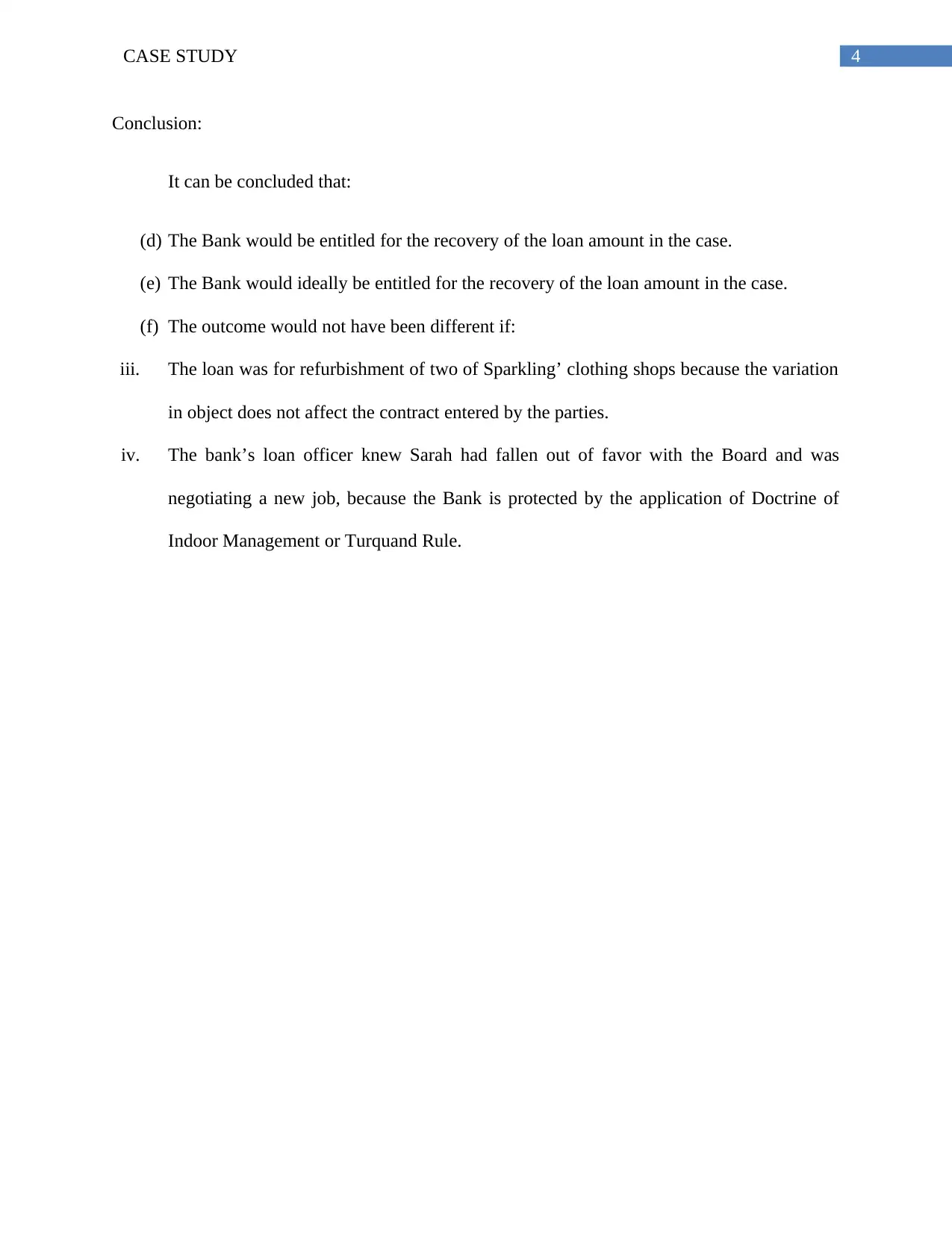
4CASE STUDY
Conclusion:
It can be concluded that:
(d) The Bank would be entitled for the recovery of the loan amount in the case.
(e) The Bank would ideally be entitled for the recovery of the loan amount in the case.
(f) The outcome would not have been different if:
iii. The loan was for refurbishment of two of Sparkling’ clothing shops because the variation
in object does not affect the contract entered by the parties.
iv. The bank’s loan officer knew Sarah had fallen out of favor with the Board and was
negotiating a new job, because the Bank is protected by the application of Doctrine of
Indoor Management or Turquand Rule.
Conclusion:
It can be concluded that:
(d) The Bank would be entitled for the recovery of the loan amount in the case.
(e) The Bank would ideally be entitled for the recovery of the loan amount in the case.
(f) The outcome would not have been different if:
iii. The loan was for refurbishment of two of Sparkling’ clothing shops because the variation
in object does not affect the contract entered by the parties.
iv. The bank’s loan officer knew Sarah had fallen out of favor with the Board and was
negotiating a new job, because the Bank is protected by the application of Doctrine of
Indoor Management or Turquand Rule.
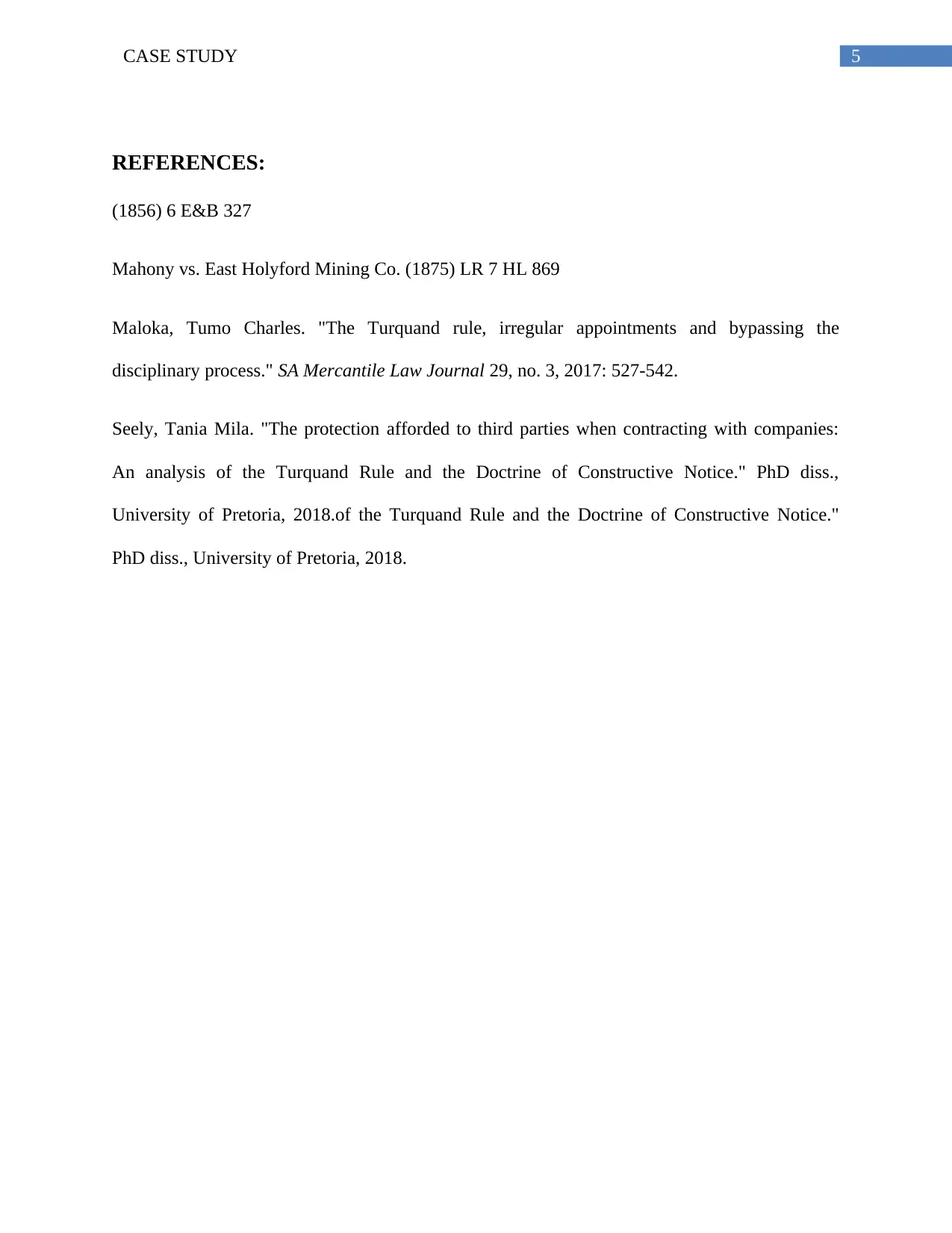
5CASE STUDY
REFERENCES:
(1856) 6 E&B 327
Mahony vs. East Holyford Mining Co. (1875) LR 7 HL 869
Maloka, Tumo Charles. "The Turquand rule, irregular appointments and bypassing the
disciplinary process." SA Mercantile Law Journal 29, no. 3, 2017: 527-542.
Seely, Tania Mila. "The protection afforded to third parties when contracting with companies:
An analysis of the Turquand Rule and the Doctrine of Constructive Notice." PhD diss.,
University of Pretoria, 2018.of the Turquand Rule and the Doctrine of Constructive Notice."
PhD diss., University of Pretoria, 2018.
REFERENCES:
(1856) 6 E&B 327
Mahony vs. East Holyford Mining Co. (1875) LR 7 HL 869
Maloka, Tumo Charles. "The Turquand rule, irregular appointments and bypassing the
disciplinary process." SA Mercantile Law Journal 29, no. 3, 2017: 527-542.
Seely, Tania Mila. "The protection afforded to third parties when contracting with companies:
An analysis of the Turquand Rule and the Doctrine of Constructive Notice." PhD diss.,
University of Pretoria, 2018.of the Turquand Rule and the Doctrine of Constructive Notice."
PhD diss., University of Pretoria, 2018.
⊘ This is a preview!⊘
Do you want full access?
Subscribe today to unlock all pages.

Trusted by 1+ million students worldwide
1 out of 6
Related Documents
Your All-in-One AI-Powered Toolkit for Academic Success.
+13062052269
info@desklib.com
Available 24*7 on WhatsApp / Email
![[object Object]](/_next/static/media/star-bottom.7253800d.svg)
Unlock your academic potential
Copyright © 2020–2025 A2Z Services. All Rights Reserved. Developed and managed by ZUCOL.





